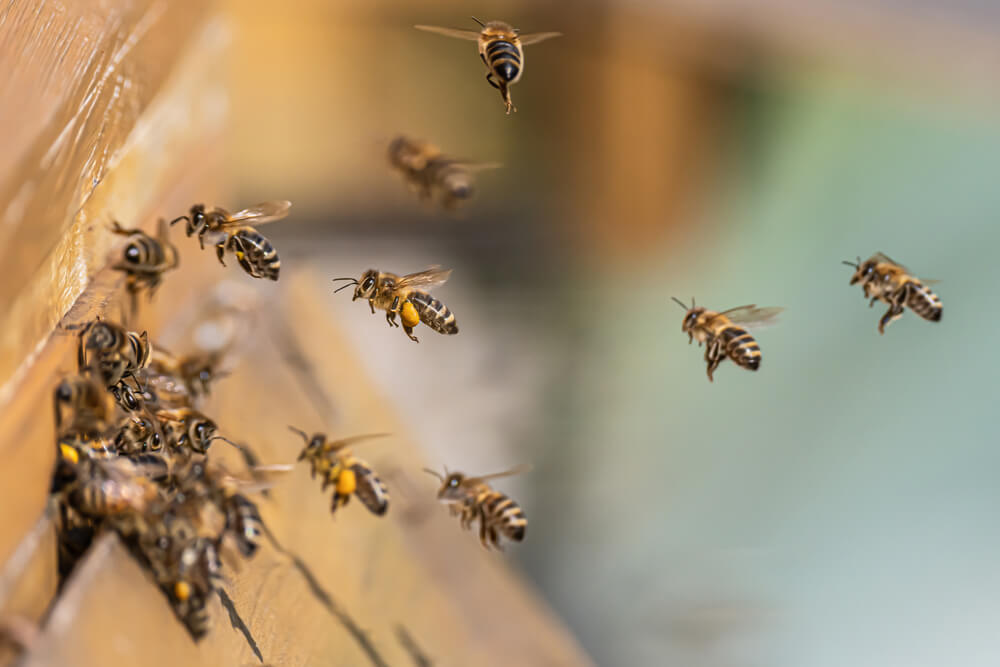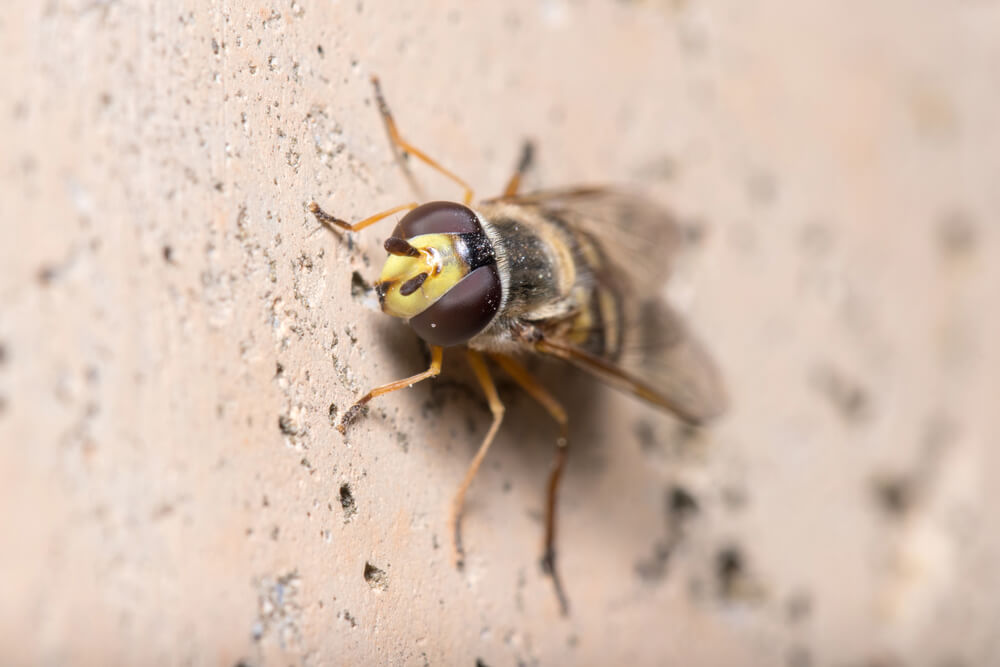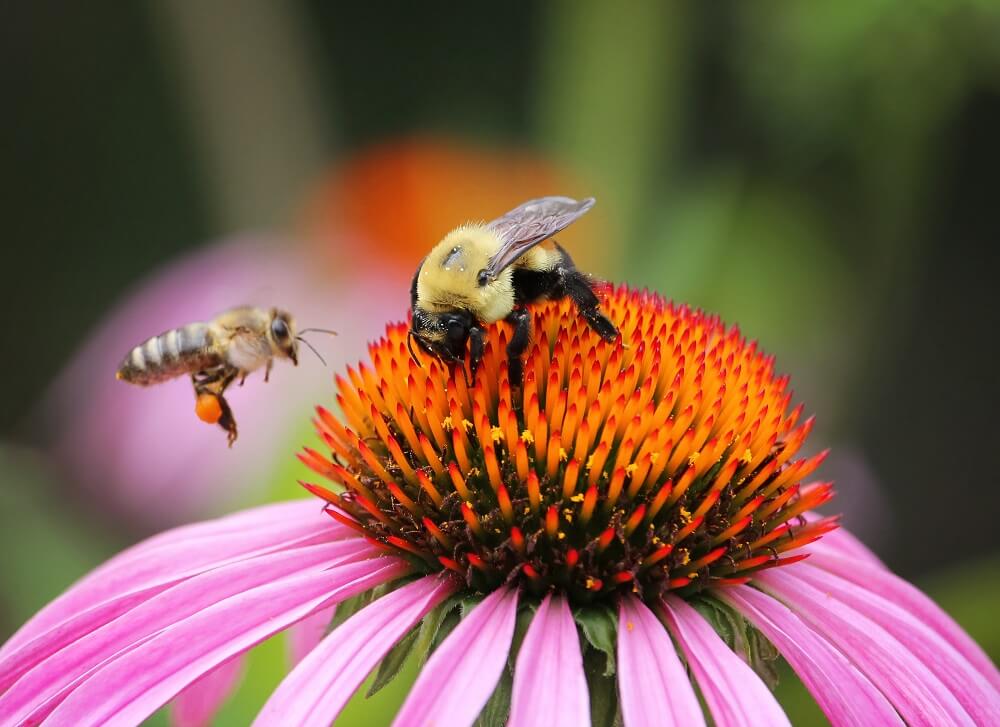Table of Contents:
How Are Queen Bees Made?
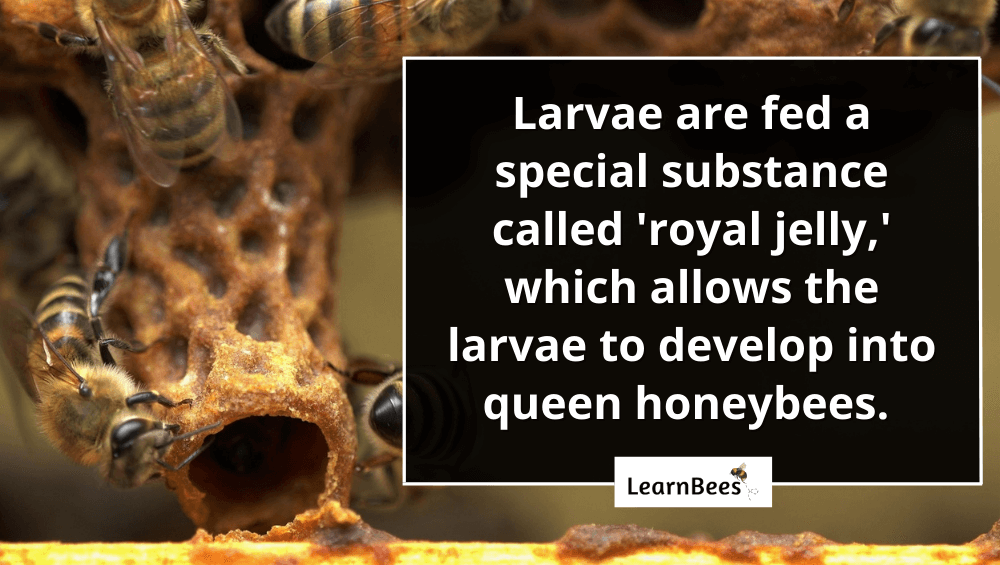
Worker honeybees make queens by feeding them a special substance called ‘royal jelly.’
Royal jelly gives larvae the nutrition they need to develop into queen bees.
It starts like this:
The honeybee colony decides they need to replace the old queen bee. This decision usually occurs once the old queen has aged and isn’t laying as many eggs as she did in her prime.
Next, the worker bees will pick multiple female larvae to become queens.
Larvae are worm-like grubs that hatch from bee eggs. At the larva stage, bees still haven’t developed their legs, eyes, wings, or other body parts.
Adult worker bees feed these special larvae a diet of ‘royal jelly.’ Remember, royal jelly is a nutritious substance that helps larvae develop into queen bees.
But here’s the kicker:
There can (usually) only be one queen honeybee per hive.
That said, the worker bees raise multiple queens at the same time as an “insurance policy.” Multiple queens may hatch, but only the strongest, fastest, and healthiest queen will survive.
What do I mean by that?
Well, this is where the tough part comes in.
Once the first queen hatches, her main priority becomes killing off the other queen bees that haven’t hatched yet. Queens find each other by letting out a high pitch chirp called ‘piping.’
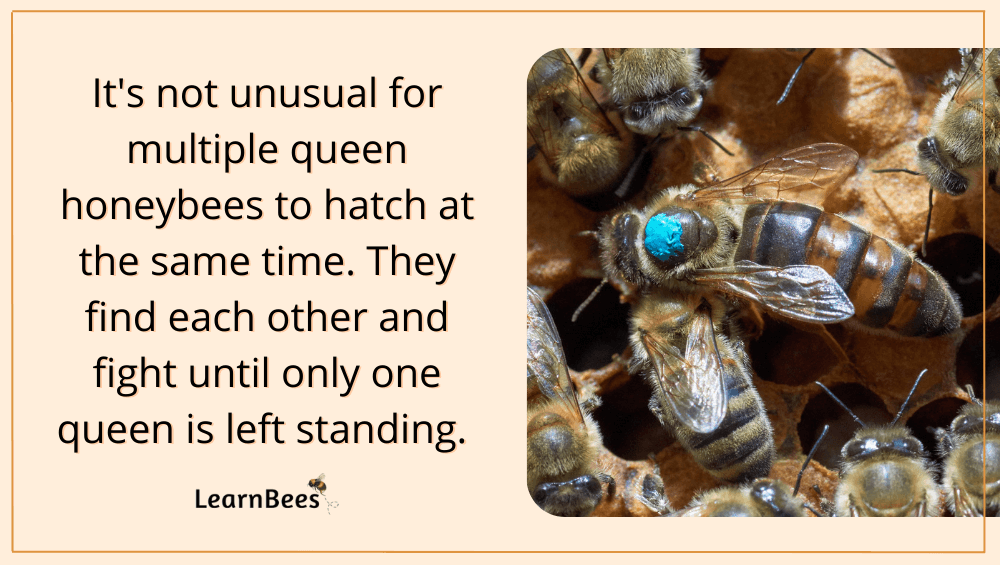
Even queens still unhatched in their queen cells will pipe back. This gives the hatched queen the chance to sting them to death before they’ve even emerged from their queen cell.
Once the battle royale is complete, the surviving queen will take a ‘mating flight.’
She leaves the hive to mate with drones (male bees) from other hives. She can mate with anywhere from 12-30 drones, giving her enough sperm to lay fertilized eggs for the rest of her life.
Once back home, the newly mated queen rarely leaves the hive.
Instead, she spends most of her time laying eggs to ensure the future generation of the colony. A healthy honeybee queen can lay 2,000 eggs per day.
How Long Does it Take to Make a Queen Bee?
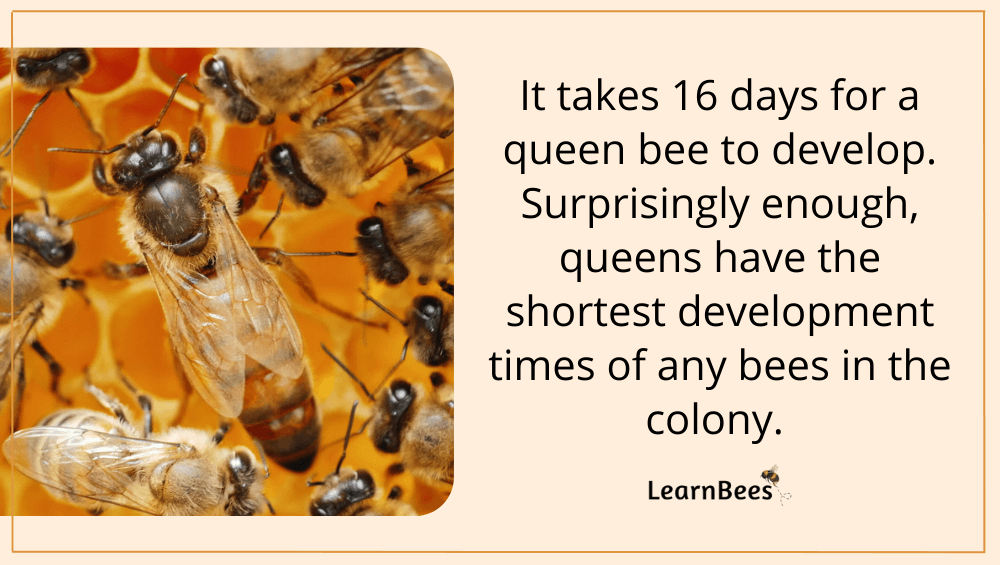
In total, it takes about 16 days to make a queen honeybee.
Surprisingly enough:
The queen honeybee has the shortest development time of any bee in the colony. Worker bees take 18-22 days to develop completely, and drones need about 24 days.
Queen bees are made under two conditions:
- Standard queen replacement
- Emergency queen replacement
The routine queen replacement is not an emergency. The queen didn’t suddenly die or get injured. In most cases, the colony senses that the queen is declining due to her age or another factor.
One example could be that the queen’s pheromones may be declining.
A queen’s pheromones are the chemical scents she releases to give the colony cues about the hive. For instance, the queen releases an alarm pheromone to alert the colony to danger.
So if a queen’s pheromones have declined due to her age, then it could pose a problem for the hive.
As a result?
The worker bees begin the process of replacing her. This starts with the current queen being encouraged to lay eggs in special queen cells. Queen cells are noticeably bigger and peanut-shaped compared to regular wax cells.
What Happens if the Queen Bee Dies Unexpectedly?
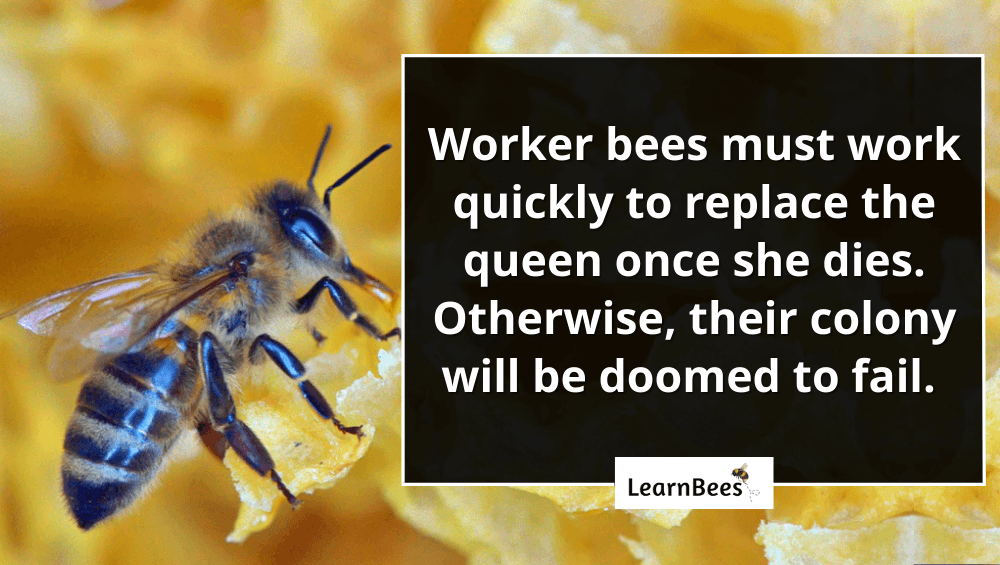
The hive goes into a panic if the queen dies randomly.
Think about it like this.
During the summer, a honeybee colony can easily lose hundreds of worker bees per day. Worker bees have short lifespans of around six weeks during the peak season.
Compare that to the queen bee lifespan, who can live two to four years.
Big difference.
As a result, these worker bee losses needed to be recouped by more eggs. But if a colony unexpectedly loses their queen, then their hive suddenly doesn’t have a queen to lay eggs.
This is when worker honeybees start the process of emergency queen rearing. It begins with them picking fresh larvae to feed the special queen diet of royal jelly. Once larva gets fed royal jelly, they’ll begin developing into queens.
Why?
Because proper nutrition is important for raising a healthy, strong queen bee.
In fact, the size of a queen bee is affected by proper feeding during the development stage. This is why sometimes emergency-reared queens aren’t always the best quality.
It’s also why it’s not uncommon for colonies to later replace emergency queens with stronger and healthier queens.
FAQs on “How Are Queen Bees Made?”
- Are queen bees made or born?
- What do queen cells look like?
- Why do worker bees create multiple queen cells?
- What season are queen bees made?
- How are queen bumblebees made?
- How are queen mason bees made?
- How are queen carpenter bees made?
- Are queen bees made by worker bees?
- Are queen bees made by drone bees?
- Can bees make their own queen?
- How does royal jelly create a queen bee?
- Will a queenless hive make a new queen?
- Do queen bees mate with their own drones?
- What happens if the queen bee gets killed?
- Are queen bees made in the same way worker bees are made?
Are queen bees made or born?
Queen bees are born as regular larvae, then fed a special diet of ‘royal jelly,’ which allows them to develop into queens.
Queens are raised in special cells known as ‘queen cells.’ Due to the larger size of the queen, the queen cells are larger and thicker than the cells used to raise worker bees or drone bees.
The location of the queen cells can depend on why the bees are building them.
For example, emergency queen cells are created when the queen unexpectedly dies. In this case, the worker bees modify existing cells to accommodate the queen.
On the other hand, routine queen replacement cells aren’t an emergency. These are planned events where the old queen declines in productivity and needs to be replaced.
In this case, these queen cells often hang off the edges or bottom of the comb. That said, the queen cells can technically be anywhere in the brood nest. They don’t necessarily follow these rules.
—> Go back to the FAQs on “How Are Queen Bees Made?”
More to Explore:
- Do Queen Bees Eat Honey?
- Are Worker Bees Male or Female?
- Queen Bee Versus Worker Bees – How Do They Compare?
What do queen cells look like?
They’re usually about an inch long, shaped like a peanut shell, and have a rough surface texture.
—> Go back to the FAQs on “How Are Queen Bees Made?”
More to Explore:
- Do Carpenter Bees Pollinate?
- How Long Do Bumble Bees Live?
- Honeybees vs. Bumblebees: How Do They Compare?
Why do worker bees create multiple queen cells?
Honeybees almost always make several queen cells. There is no reason to be concerned if you see this happening. They do this as a kind of insurance policy.
It’s not uncommon for multiple queens to hatch at a single time. The strongest and fastest queen will fight it out with the others until only one is left standing.
—> Go back to the FAQs on “How Are Queen Bees Made?”
More to Explore:
What season are queen bees made?
Queen honeybees can be hatched any time during the spring, summer, or fall.
For example, if the old queen suddenly dies, the colony needs to raise a new queen to replace her – no matter the season.
That said, most queens are made during peak honeybee season, which is spring or summer. This is when honeybees are most likely to swarm.
Swarming is a process where the colony creates a new queen and then divides into two. Essentially, half the colony “moves out” and finds a new home.
Swarming sometimes occurs when the hive has become overcrowded with bees.
Swarming also occurs because it’s a natural instinct of honeybees. This is how they reproduce and add more bee colonies into the wild.
—> Go back to the FAQs on “How Are Queen Bees Made?”
More to Explore:
- Ground Bees: Are They a Threat to Your Yard?
- Wasps vs. Honeybees: Are They Different?
- Do Bumble Bees Bite?
How are queen bumblebees made?
It’s believed that queen bumblebees secrete a pheromone which helps determine if the bee will become a worker bumblebee or a future queen bumblebee.
If the pheromone is secreted within the first five days of the larval life, then the larva will develop into a worker bumblebee. If the pheromone is absent and the larva receives special food, it will grow into a queen bumblebee.
Additionally, the queen larva is bigger than the worker larva.
—> Go back to the FAQs on “How Are Queen Bees Made?”
More to Explore:
How are queen mason bees made?
Keep in mind that mason bees are solitary bees that live alone. They don’t live in social bee colonies.
So what does this mean?
It means that every female mason bee is technically a ‘queen.’ She lives alone and is responsible for nesting and laying eggs that ensure the future generation of mason bees.
Mason bees nest in tunnels such as woodpecker holes or manmade holes. The female mason bees lay eggs inside the tunnel and seals between eggs with mud. She places pollen and nectar beside each egg so they have something to eat while they hatch.
These eggs eventually hatch into larva, then spin a cocoon and pupate. They remain inside their cocoons throughout winter, then emerge in the spring once the temperature warms.
—> Go back to the FAQs on “How Are Queen Bees Made?”
More to Explore:
How are queen carpenter bees made?
Most carpenter bee species are solitary bees that live alone.
This means that every female carpenter bee is technically considered a ‘queen.’
Carpenter bees nest in wood. The female bee will find a suitable nesting spot, then create a series of tunnels inside the wood.
She’ll lay an egg inside each tunnel and seal it off with regurgitated wood pulp. The egg hatches into a larva which eventually spins a cocoon and pupates.
—> Go back to the FAQs on “How Are Queen Bees Made?”
More to Explore:
Are queen bees made by worker bees?
Yes, larvae are fed a special diet by worker bees to develop into queen bees. This diet is called royal jelly. Royal jelly is a secretion from the hypopharyngeal glands of young worker bees.
That said, this process starts with the queen bee laying fertilized eggs.
—> Go back to the FAQs on “How Are Queen Bees Made?”
More to Explore:
Are queen bees made by drone bees?
No, drone bees don’t make queens.
Drones are male bees that have a sole job of mating with queens from other hives. They don’t make honey, collect food, clean, or even defend the hive. These job duties are left up to worker honeybees.
—> Go back to the FAQs on “How Are Queen Bees Made?”
More to Explore:
Can bees make their own queen?
Yes, queens are technically made by worker honeybees who feed the larva a nutritious diet of royal jelly.
In a nutshell:
The larva starts as regular larva, but they change into queens through royal jelly. That said, this process cannot be started without the queen bee. Only the queen bee can lay fertilized eggs.
—> Go back to the FAQs on “How Are Queen Bees Made?”
More to Explore:
How does royal jelly create a queen bee?
Because royal jelly is an incredibly nutritious substance made of proteins and fatty acids. This nutritious diet helps the larva develop into a queen bee.
—> Go back to the FAQs on “How Are Queen Bees Made?”
More to Explore:
Will a queenless hive make a new queen?
Yes, a hive will try to make a new queen if the old one dies. Sometimes they are successful, sometimes they aren’t.
When a hive is queenless, the worker bees will begin trying to raise new queens within 24 hours. This process is called emergency queen rearing.
In total, it takes about 16 days from egg to hatching for the queen to develop.
—> Go back to the FAQs on “How Are Queen Bees Made?”
More to Explore:
Do queen bees mate with their own drones?
No, queen bees mate with drones from other hives.
Mating occurs outside of the hive in a process called mating flights or nuptial flights. Once the queen mates, she stores sperm in her spermatheca (an organ in her abdomen). She can use this stored sperm to lay eggs for the rest of her life.
The drones die after they mate because their reproductive organs are torn from their bodies.
—> Go back to the FAQs on “How Are Queen Bees Made?”
More to Explore:
What happens if the queen bee gets killed?
If the queen bee is killed, the hive will go into a state of emergency. The worker bees will begin raising new queens within 24 hours. This process is called emergency queen rearing.
In total, it takes about 16 days from egg to hatching for the queen to develop.
—> Go back to the FAQs on “How Are Queen Bees Made?”
More to Explore:
Are queen bees made in the same way worker bees are made?
Queen honeybees begin the same way as worker bees.
They’re made from fertilized eggs laid by the hive’s queen bee. Then, after the egg hatches and becomes a larva, it’s fed a special diet (royal jelly) that allows it to grow into a queen bee.
